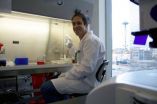(Press-News.org) Scientists from the University of Hawaii at Manoa (UHM) published a study today in Nature Climate Change showing that besides marine inundation (flooding), low-lying coastal areas may also be vulnerable to "groundwater inundation," a factor largely unrecognized in earlier predictions on the effects of sea level rise (SLR). Previous research has predicted that by the end of the century, sea level may rise 1 meter. Kolja Rotzoll, Postdoctoral Researcher at the UHM Water Resources Research Center and Charles Fletcher, UHM Associate Dean, found that the flooded area in urban Honolulu, Hawaii, including groundwater inundation, is more than twice the area of marine inundation alone. Specifically, a 1-meter rise in sea level would inundate 10% of a 1-km wide heavily urbanized area along the shoreline of southern Oahu and 58% of the total flooded area is due to groundwater inundation.
"With groundwater tables near the ground surface, excluding groundwater inundation may underestimate the true threat to coastal communities," said Rotzoll, lead author of the study.
"This research has implications for communities that are assessing options for adapting to SLR. Adapting to marine inundation may require a very different set of options and alternatives than adapting to groundwater inundation," states Fletcher, Principle Investigator on the grant that funded the research.
Groundwater inundation is localized coastal-plain flooding due to a simultaneous rise of the groundwater table with sea level. Groundwater inundation is an additional risk faced by coastal communities and environments before marine flooding occurs because the groundwater table in unconfined aquifers typically moves with the ocean surface and lies above mean sea level at some distance from the shoreline.
Rotzoll and Fletcher combined measurements of the coastal groundwater elevation and tidal influence in urban Honolulu with a high-resolution digital elevation model. With this, they were able to assess vulnerability to groundwater inundation from SLR.
"We used the digital elevation model with our improved understanding of groundwater processes to identify areas vulnerable to marine inundation and groundwater inundation," Rotzoll explained. "It turned out that groundwater inundation poses a significant threat that had not been previously recognized."
Although effects of SLR on coastal areas have been discussed for a long time, this study is the first to explicitly assess the effects of including groundwater dynamics.
"Finding that the inundated areas double when including groundwater inundation in coastal flooding scenarios will certainly be a surprise for everyone assessing the effects of SLR without considering the local groundwater table," said Rotzoll. "We hope other coastal communities use our research as the basis for conducting their own localized analysis."
Strong evidence on climate change underscores the need for actions to reduce the impacts of SLR. Groundwater inundation has consequences for decision-makers, resource managers, and urban planners and may be applicable to many low-lying coastal areas, especially where the groundwater table is near the ground surface and groundwater withdrawal is not substantial. However, groundwater withdrawals can be used to mitigate effects of a rising water table, even if it means pumping brackish water to avoid inundation.
The authors will present the findings from this paper at two international meetings: the Geological Society of America Annual Meeting (Charlotte, NC) and the American Geophysical Union Fall Meeting (San Francisco, CA).
The study's authors plan to substantiate their assessment of the groundwater table with further measurements throughout the coastal Honolulu caprock aquifer and improve understanding of the dynamics of the water table.
INFORMATION:
Rotzoll, K. and Fletcher, C.H. Assessment of groundwater inundation as a consequence of sea-level rise. Nature Climate Change, DOI: 10.1038/NCLIMATE1725
'Groundwater inundation' doubles previous predictions of flooding with future sea level rise
2012-11-12
ELSE PRESS RELEASES FROM THIS DATE:
Game changer for arthritis and anti-fibrosis drugs
2012-11-12
(SALT LAKE CITY)—In a discovery that can fundamentally change how drugs for arthritis, and potentially many other diseases, are made, University of Utah medical researchers have identified a way to treat inflammation while potentially minimizing a serious side effect of current medications: the increased risk for infection.
These findings provide a new roadmap for making powerful anti-inflammatory medicines that will be safer not only for arthritis patients but also for millions of others with inflammation-associated diseases, such as diabetes, traumatic brain injury, ...
CSHL-led team discovers new way in which plants control flower production
2012-11-12
Cold Spring Harbor, N.Y. – Flowers don't just catch our eyes, they catch those of pollinators like bees as well. They have to, in order to reproduce. Because plants need to maximize the opportunity for pollinators to gain access to their seeds, variations in the timing of flowering can have profound effects on flower, fruit, and seed production, and consequently agricultural yields.
We know that the major driving forces of flowering are external factors such as light and temperature. However, new research from CSHL Assistant Professor Zach Lippman, Ph.D. and his collaborators, ...
Mutations in genes that modify DNA packaging result in Facioscapulohumeral Muscular Dystrophy
2012-11-12
A recent finding by medical geneticists sheds new light on how Facioscapulohumeral Muscular Dystrophy develops and how it might be treated. More commonly known as FSHD, the devastating disease affects both men and women.
FSHD is usually an inherited genetic disorder, yet sometimes appears spontaneously via new mutations in individuals with no family history of the condition.
"People with the condition experience progressive muscle weakness and about 1 in 5 require wheelchair assistance by age 40," said Dr. Daniel G. Miller, University of Washington associate professor ...
Study provides recipe for 'supercharging' atoms with X-ray laser
2012-11-12
Researchers using the Linac Coherent Light Source (LCLS) at the U.S. Department of Energy's (DOE) SLAC National Accelerator Laboratory have found a way to strip most of the electrons from xenon atoms, creating a "supercharged," strongly positive state at energies previously thought too low.
The findings, which defy expectations and theory, could help scientists deliberately induce the high levels of damage needed to study extreme states of matter or ward off damage in samples they're trying to image. The results were reported this week in Nature Photonics.
While the ...
Why Antarctic sea ice cover has increased under the effects of climate change
2012-11-12
The first direct evidence that marked changes to Antarctic sea ice drift have occurred over the last 20 years, in response to changing winds, is published this week in the journal Nature Geoscience. Scientists from NERC's British Antarctic Survey (BAS) and NASA's Jet Propulsion Laboratory (JPL), Pasadena California explain why, unlike the dramatic losses reported in the Arctic, the Antarctic sea ice cover has increased under the effects of climate change.
Maps created by JPL using over 5 million individual daily ice motion measurements captured over a period of 19 years ...
Did wild birds cause the 2010 deadly West Nile virus outbreak in Greece?
2012-11-12
In 2010, 35 people in Greece died from a West Nile virus (WNV) outbreak, with a further 262 laboratory-confirmed human cases. A new article published in BioMedCentral's open access journal Virology Journal examines whether wild or migratory birds could have been responsible for importing and amplifying the deadly virus.
WNV is a flavivirus of major public health concern, spread through the bite of infected mosquitoes. Discovered in Uganda in 1937, it was only sporadically reported up until the 1990s, after which disease outbreaks were reported world-over, leading to ...
Scientists discover new method of gene identification
2012-11-12
Scientists studying the genes and proteins of human cells infected with a common cold virus have identified a new gene identification technique that could increase the genetic information we hold on animals by around 70 to 80 per cent. The findings, published in Nature Methods, could revolutionise our understanding of animal genetics and disease, and improve our knowledge of dangerous viruses such as SARS that jump the species barrier from animals to humans.
Modern advances in genome sequencing — the process of determining the genetic information and variation controlling ...
Cultural dimensions of climate change are underestimated, overlooked and misunderstood
2012-11-12
The impact of climate change on many aspects of cultural life for people all over the world is not being sufficiently accounted for by scientists and policy-makers. University of Exeter-led research by an international team, published on 11th November in Nature Climate Change, shows that cultural factors are key to making climate change real to people and to motivating their responses.
From enjoying beaches or winter sports and visiting iconic natural spaces to using traditional methods of agriculture and construction in our daily lives, the research highlights the cultural ...
Making a better invisibility cloak
2012-11-12
DURHAM, N.C. -- The first functional "cloaking" device reported by Duke University electrical engineers in 2006 worked like a charm, but it wasn't perfect. Now a member of that laboratory has developed a new design that ties up one of the major loose ends from the original device.
These new findings could be important in transforming how light or other waves can be controlled or transmitted. Just as traditional wires gave way to fiber optics, the new meta-material could revolutionize the transmission of light and waves.
Because the goal of this type of research involves ...
Schizophrenia genetic networks identified; Connection to autism found
2012-11-12
New York, NY (November 11, 2012) — Although schizophrenia is highly genetic in origin, the genes involved in the disorder have been difficult to identify. In the past few years, researchers have implicated several genes, but it is unclear how they act to produce the disorder. A new study by researchers at Columbia University Medical Center identifies affected gene networks and provides insight into the molecular causes of the disease.
The paper was published today in the online edition of the journal Nature Neuroscience.
Using an unbiased collection of hundreds of mutations ...




